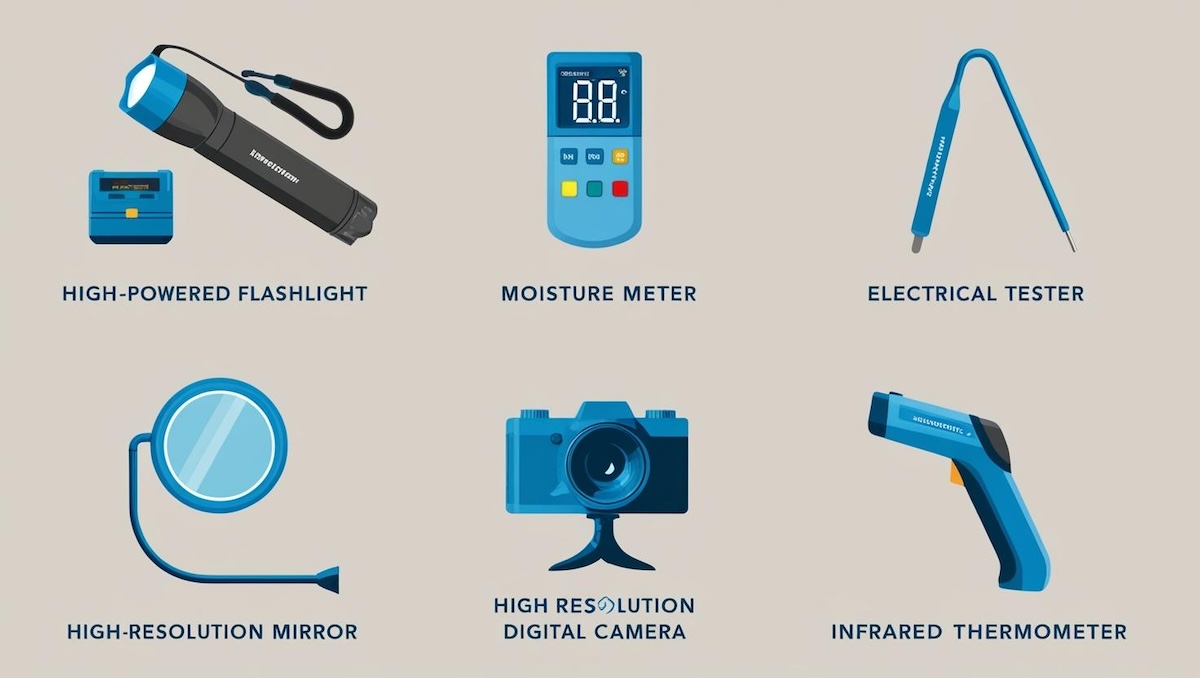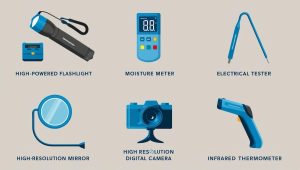Hey there! Let me save you about $1,000 in unnecessary gadgets (you can thank me later ). After years of crawling through attics and poking around basements, I’ve figured out exactly what tools you actually need – and which ones are just collecting dust in my trunk.
The Must-Haves (Trust Me On These!)
1. **A Really Good Flashlight** ($50-100)
Listen, your phone flashlight isn’t going to cut it in a dark crawl space! I use the Milwaukee USB Rechargeable – it’s survived three drops from the attic and still works perfectly. Get one with at least 1000 lumens and a backup battery.
2. **Moisture Meter** ($100-150)
That suspicious spot on the ceiling? Your moisture meter will tell you if it’s active water damage or just old Uncle Bob’s failed plumbing adventure from 1992. The Protimeter Mini is my go-to – it hasn’t steered me wrong yet!
3. **Electrical Tester** ($30-50)
Unless you enjoy surprise tingles (please don’t!), grab a good outlet tester. Klein Tools makes one that’s basically indestructible. Pro tip: Get one that tests GFCI outlets too – it’ll save you tons of time.
4. **Digital Camera** ($300-500)
“But Kim, my phone has a camera!” True, but try using it in a pitch-black attic while holding a flashlight. I learned this one the hard way! A good camera with a flash will make your reports look super professional.
5. **Inspection Mirror** ($15-20)
For seeing behind water heaters and checking those impossible angles. It’s saved my back more times than I can count!
## The Nice-to-Haves
6. **Infrared Thermometer** ($30-50)
Perfect for checking heating/cooling systems and finding sneaky air leaks. Plus, clients think it’s pretty cool when you can tell them their fridge is exactly 40.2 degrees!
7. **Ladder** ($150-200)
Get a sturdy 17-footer that folds down small. And yes, I learned about ladder stability the fun way (my pride was more bruised than my bottom, thankfully ).
8. **Basic Tool Kit** ($100)
Screwdrivers, pliers, measuring tape – you know the drill. Nothing fancy needed here!
## The Really-Nice-to-Haves
9. **Carbon Monoxide Detector** ($100-150)
Because nobody wants to find out about a furnace leak the hard way.
10. **Tablet/iPad** ($300+)
For taking notes and filling out reports on the go. Game-changer for productivity!
## 5 Tools You Can Skip (Save Your Money!)
1. ❌ Fancy Drone
Unless you’re specializing in luxury homes, that $1,000 drone will mostly take pretty pictures of your neighbor’s yard.
2. ❌ Super Expensive Thermal Camera
The $4,000 models are amazing, but the $200 ones will spot most issues just fine.
3. ❌ Professional Grade Gas Detector
Unless you’re doing commercial inspections, your CO detector’s got you covered.
4. ❌ Specialized Plumbing Camera
Leave the pipe adventures to the plumbers!
5. ❌ Heavy Duty Voltage Meter
The basic electrical tester will handle 99% of what you need.
Money-Saving Pro Tips
* Buy tools gradually as you build your business
* Check for refurbished options on the expensive stuff
* Join inspector groups on Facebook – people often sell gently used equipment
* Start with the must-haves and add others as you need them
The Bottom Line
You don’t need to spend $5,000 on tools to start inspecting houses. Begin with the must-haves (about $600 total) and add others as you go. Remember: it’s not about having the fanciest gadgets – it’s about knowing how to use what you have!
Got questions about specific tools? Drop them in the comments! I’d love to share more stories about my equipment adventures (like that time my moisture meter saved a $300,000 home sale! ).
Want more home inspector tips? Check out my guides on:
* Starting Your Home Inspection Business
* Writing Reports That Don’t Put People to Sleep
* Marketing Without Being Super Awkward
How about you? What’s your favorite inspection tool? Let me know below!


Leave a Reply